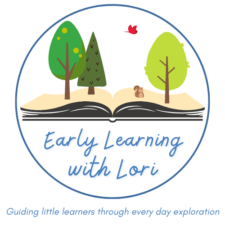Rainforest Habitat Sensory Bin for Preschool Jungle Play

A rainforest habitat sensory bin for preschool is the perfect hands-on way to explore the animals, plants, and weather of this lush environment. Whether you’re planning a rainforest week or adding to a zoo animal theme, this activity invites open-ended exploration while teaching about food, water, shelter, and space.
For my classroom, I chose a dry bin, making it easy to prep, low mess, and toddler-friendly! For the photo above, I show an option with water!
What Is a Habitat?
A habitat is a place where an animal lives. Every animal needs food, water, shelter, and space. In the rainforest, animals live in warm, wet places filled with tall trees, leafy plants, and vines. Some live high up in the trees, while others crawl or hop along the forest floor.
When children explore a rainforest bin, they’re learning what animals need to survive—and how plants and animals share the same space.
Introducing the Rainforest Habitat Sensory Bin
Begin with a short discussion at circle time:
“The rainforest is a warm place with lots of rain and green plants. Many animals live in the trees and on the ground. What animals do you think live there? What do they eat? Where might they hide or sleep?”
You can show photos or use toy animals to prompt conversation:
- Monkeys swing in trees.
- Frogs and snakes hide in the leaves.
- Birds fly above the trees to look for food.
Then invite the children to explore the bin like scientists—looking for clues about what the animals might do.
What’s in the Rainforest Habitat Sensory Bin?
Use a shallow bin or tray for easy setup and cleanup. I like to set up 2-4 small trays instead of using the large sensory bin to make it easy to change out the habitats. Here are a few non-food material options:
This dry rainforest habitat sensory bin for preschool includes:
- Green or blue aquarium gravel, pieces or artificial turn, felt leaves, or raffia grass
- Plastic rainforest animals (frogs, monkeys, snakes, jaguars, toucans, etc.)
- Artificial vines, leaves, and flower cuttings (from dollar store bouquets)
- Small logs or cardboard tubes (to create forest layers)
- Sections of pool noodles

Optional Wet Version
- Add a thin layer of water
- Use plastic greenery or pieces of pool noodle for land (Be sure to have plenty of noodle pieces on hand. The students loved pushing the ferns and greenery pieces into the noodles to make trees.)
- Include scoops, tongs, or nets for fine motor practice

Older Preschoolers (4s–K)
Encourage older kids to build more complex scenes:
- Create “tree canopies” with with a wire rack and greenery
- Sort animals by layer (forest floor, understory, canopy)
- Add small rocks or stumps for hiding places
- Introduce rainforest vocabulary like jungle, vines, damp, canopy, or tropical
Prompt dramatic play and storytelling:
- “What happens if it rains?”
- “Can your animals find food and shelter?”
After talking about canopies, my students asked for a way to make a tree canopy. We came up with the idea of using a wire rack. Here is wha they built.


The open-ended nature of the bin allowed for both creative and scientific thinking.
Alternatives Rainforest Bin Supplies for Toddlers
For my two-year-olds, I adjusted the supplies to make the bin easier to use. Here’s some of the supplies I used for this age group.
- Use large plastic animals with no small pieces
- Line the bottom with green felt or fabric for the ground
- Add pieces of green and blue pool noodles for water and land.
- Offer fewer materials at once to reduce overwhelm
- Skip vines or dangling greenery (We cut up a hula skirt to use as vines and groundcover)
- Add scoops or cups for sorting and moving animals

Focus on labeling animals and encouraging gentle pretend play:
“Can you find the frog?”
“Let’s help the monkey climb a tree!”

What Children Learn
- Science: ecosystems, animal needs, biodiversity
- Language: animal names, descriptive words
- Fine motor skills: scooping, sorting, arranging
- Creative thinking: story building and open-ended play
Set Up and Storage Tips
- Use a shallow plastic bin or tray
- Place a towel or mat underneath for easy cleanup
- Store leaves, animals, and logs in labeled bags or bins
- Refresh the materials with seasonal or theme-based swaps
Related Posts and Resources
Set up a zoo in your classroom using everyday materials. Preschool Zoo Habitat Activity: Create Animal Habitats
This paper folding craft helps students explore animal habitats through fine motor craft.
Here’s a free movement game that you can play indoor or out.





